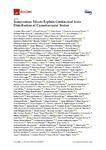Mostrar o rexistro simple do ítem
Temperature effects explain continental scale distribution of cyanobacterial toxins
| dc.contributor.author | Mantzouki, Evanthia | |
| dc.contributor.author | Delgado Martín, Jordi | |
| dc.contributor.author | García, David | |
| dc.contributor.author | Cereijo Arango, José Luis | |
| dc.contributor.author | Carballeira, Rafael | |
| dc.contributor.author | Ibelings, Bas W. | |
| dc.date.accessioned | 2018-09-28T11:44:29Z | |
| dc.date.available | 2018-09-28T11:44:29Z | |
| dc.date.issued | 2018-04-13 | |
| dc.identifier.citation | Mantzouki, E.; Lürling, M.; Fastner, J.; de Senerpont Domis, L.; Wilk-Woźniak, E.; Koreivienė, J.; Seelen, L.; Teurlincx, S.; Verstijnen, Y.; Krztoń, W.; Walusiak, E.; Karosienė, J.; Kasperovičienė, J.; Savadova, K.; Vitonytė, I.; Cillero-Castro, C.; Budzyńska, A.; Goldyn, R.; Kozak, A.; Rosińska, J.; Szeląg-Wasielewska, E.; Domek, P.; Jakubowska-Krepska, N.; Kwasizur, K.; Messyasz, B.; Pełechata, A.; Pełechaty, M.; Kokocinski, M.; García-Murcia, A.; Real, M.; Romans, E.; Noguero-Ribes, J.; Duque, D.P.; Fernández-Morán, E.; Karakaya, N.; Häggqvist, K.; Demir, N.; Beklioğlu, M.; Filiz, N.; Levi, E.E.; Iskin, U.; Bezirci, G.; Tavşanoğlu, Ü.N.; Özhan, K.; Gkelis, S.; Panou, M.; Fakioglu, Ö.; Avagianos, C.; Kaloudis, T.; Çelik, K.; Yilmaz, M.; Marcé, R.; Catalán, N.; Bravo, A.G.; Buck, M.; Colom-Montero, W.; Mustonen, K.; Pierson, D.; Yang, Y.; Raposeiro, P.M.; Gonçalves, V.; Antoniou, M.G.; Tsiarta, N.; McCarthy, V.; Perello, V.C.; Feldmann, T.; Laas, A.; Panksep, K.; Tuvikene, L.; Gagala, I.; Mankiewicz-Boczek, J.; Yağcı, M.A.; Çınar, Ş.; Çapkın, K.; Yağcı, A.; Cesur, M.; Bilgin, F.; Bulut, C.; Uysal, R.; Obertegger, U.; Boscaini, A.; Flaim, G.; Salmaso, N.; Cerasino, L.; Richardson, J.; Visser, P.M.; Verspagen, J.M.H.; Karan, T.; Soylu, E.N.; Maraşlıoğlu, F.; Napiórkowska-Krzebietke, A.; Ochocka, A.; Pasztaleniec, A.; Antão-Geraldes, A.M.; Vasconcelos, V.; Morais, J.; Vale, M.; Köker, L.; Akçaalan, R.; Albay, M.; Špoljarić Maronić, D.; Stević, F.; Žuna Pfeiffer, T.; Fonvielle, J.; Straile, D.; Rothhaupt, K.-O.; Hansson, L.-A.; Urrutia-Cordero, P.; Bláha, L.; Geriš, R.; Fránková, M.; Koçer, M.A.T.; Alp, M.T.; Remec-Rekar, S.; Elersek, T.; Triantis, T.; Zervou, S.-K.; Hiskia, A.; Haande, S.; Skjelbred, B.; Madrecka, B.; Nemova, H.; Drastichova, I.; Chomova, L.; Edwards, C.; Sevindik, T.O.; Tunca, H.; Önem, B.; Aleksovski, B.; Krstić, S.; Vucelić, I.B.; Nawrocka, L.; Salmi, P.; Machado-Vieira, D.; de Oliveira, A.G.; Delgado-Martín, J.; García, D.; Cereijo, J.L.; Gomà, J.; Trapote, M.C.; Vegas-Vilarrúbia, T.; Obrador, B.; Grabowska, M.; Karpowicz, M.; Chmura, D.; Úbeda, B.; Gálvez, J.Á.; Özen, A.; Christoffersen, K.S.; Warming, T.P.; Kobos, J.; Mazur-Marzec, H.; Pérez-Martínez, C.; Ramos-Rodríguez, E.; Arvola, L.; Alcaraz-Párraga, P.; Toporowska, M.; Pawlik-Skowronska, B.; Niedźwiecki, M.; Pęczuła, W.; Leira, M.; Hernández, A.; Moreno-Ostos, E.; Blanco, J.M.; Rodríguez, V.; Montes-Pérez, J.J.; Palomino, R.L.; Rodríguez-Pérez, E.; Carballeira, R.; Camacho, A.; Picazo, A.; Rochera, C.; Santamans, A.C.; Ferriol, C.; Romo, S.; Soria, J.M.; Dunalska, J.; Sieńska, J.; Szymański, D.; Kruk, M.; Kostrzewska-Szlakowska, I.; Jasser, I.; Žutinić, P.; Gligora Udovič, M.; Plenković-Moraj, A.; Frąk, M.; Bańkowska-Sobczak, A.; Wasilewicz, M.; Özkan, K.; Maliaka, V.; Kangro, K.; Grossart, H.-P.; Paerl, H.W.; Carey, C.C.; Ibelings, B.W. Temperature Effects Explain Continental Scale Distribution of Cyanobacterial Toxins. Toxins 2018, 10, 156. | es_ES |
| dc.identifier.issn | 2072-6651 | |
| dc.identifier.uri | http://hdl.handle.net/2183/21085 | |
| dc.description.abstract | [Abstract] Insight into how environmental change determines the production and distribution of cyanobacterial toxins is necessary for risk assessment. Management guidelines currently focus on hepatotoxins (microcystins). Increasing attention is given to other classes, such as neurotoxins (e.g., anatoxin-a) and cytotoxins (e.g., cylindrospermopsin) due to their potency. Most studies examine the relationship between individual toxin variants and environmental factors, such as nutrients, temperature and light. In summer 2015, we collected samples across Europe to investigate the effect of nutrient and temperature gradients on the variability of toxin production at a continental scale. Direct and indirect effects of temperature were the main drivers of the spatial distribution in the toxins produced by the cyanobacterial community, the toxin concentrations and toxin quota. Generalized linear models showed that a Toxin Diversity Index (TDI) increased with latitude, while it decreased with water stability. Increases in TDI were explained through a significant increase in toxin variants such as MC-YR, anatoxin and cylindrospermopsin, accompanied by a decreasing presence of MC-LR. While global warming continues, the direct and indirect effects of increased lake temperatures will drive changes in the distribution of cyanobacterial toxins in Europe, potentially promoting selection of a few highly toxic species or strains. | es_ES |
| dc.language.iso | eng | es_ES |
| dc.publisher | MDPI | es_ES |
| dc.relation.uri | https://doi.org/10.3390/toxins10040156 | es_ES |
| dc.rights | Atribución 3.0 España | es_ES |
| dc.rights.uri | http://creativecommons.org/licenses/by/3.0/es/ | * |
| dc.subject | Microcystin | es_ES |
| dc.subject | Anatoxin | es_ES |
| dc.subject | Cylindrospermopsin | es_ES |
| dc.subject | Temperature | es_ES |
| dc.subject | Direct effects | es_ES |
| dc.subject | Indirect effects | es_ES |
| dc.subject | Spatial distribution | es_ES |
| dc.subject | European Multi Lake Survey | es_ES |
| dc.title | Temperature effects explain continental scale distribution of cyanobacterial toxins | es_ES |
| dc.type | info:eu-repo/semantics/article | es_ES |
| dc.rights.access | info:eu-repo/semantics/openAccess | es_ES |
| UDC.journalTitle | Toxins | es_ES |
| UDC.volume | 10 | es_ES |
| UDC.issue | 4 | es_ES |
| UDC.startPage | 156 | es_ES |
Ficheiros no ítem
Este ítem aparece na(s) seguinte(s) colección(s)
-
GI-GRICA - Artigos [49]






